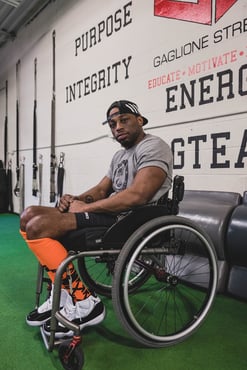Get Back Into Society After a Spinal Cord Injury
Join Our Movement
What started as an idea has become a national movement. With your support, we can influence policy and inspire lasting change.
Become an Advocate
Step 3: “Appearance”
When it comes to getting acclimated back into society, appearance plays an important role. Let's start with clothing apparel. Depending on your level of injury, it can be imperative that you select clothing based on your abilities. As a paraplegic, one of my initial goals during rehabilitation was to be able to dress independently. Once I was able to do so, it opened up the options I would have in selecting clothing. For individuals that are quadriplegic, it may be a little more difficult to find the items that make you feel confident when you are out on a date or on a job interview. There are some cool adaptive choices made by Tommy Hilfiger, Zappos, and many other brands that are making clothing more accessible. I was always taught to dress how I feel, as well as your appearance means a lot. So, in short, my advice is to try to always look presentable when you go outside, just as you would when you were ambulatory.
Step 4 “Wheelchair Mobility”
For those of us who have spinal cord injuries that require the use of a wheelchair, it is very important that your wheelchair skills are up to par. The last thing you want to find yourself doing is trying to get off of the floor or sidewalk. For manual wheelchair users, I recommend learning how to pop a wheelie, jump your chair from side to side, and work on popping up and down curbs. You can perform these with and without tippers; however, I wouldn't take the tippers off until you are fully independent and proficient at performing those movements. This will increase your accessibility tremendously. The more independent you are when you are outside, the better your experience will be each and every time.
Step 5 “Don’t be Afraid to ask for help”
Hey, I know throughout this blog I have been preaching independence as much as possible. I am also going to make you aware that sometimes you may need help. Whether it is a door that’s too heavy or a curb you can’t get up, it's ok to ask strangers for help. I had plenty of times where I needed help from a stranger. At first, I was reluctant and somewhat shy to ask people to help me with something. People are very willing to help most of the time, so don't be afraid to say, “Hey, can you please give me a hand.” The goal is to make everything as easy as possible for yourself.
Please follow me on Instagram @garrisonredd and visit thegarrisonreddproject.org.
 Being that I am a para, my goal for myself and my medical team was for me to be fully independent prior to leaving the rehabilitation center. This is the real first step. However, for the purposes of this blog, I will be outlining the steps I took after I left rehab, knowing I would be capable of living on my own if I had to. Fortunately, I was still living with my parents, and they were a tremendous help.
Being that I am a para, my goal for myself and my medical team was for me to be fully independent prior to leaving the rehabilitation center. This is the real first step. However, for the purposes of this blog, I will be outlining the steps I took after I left rehab, knowing I would be capable of living on my own if I had to. Fortunately, I was still living with my parents, and they were a tremendous help.